Infatuated with the swirling pace of life, William Glackens never lost touch with his roots as an artist-reporter. A journalist’s passion for vividly documenting firsthand experience marks his contribution to American art.
“William Glackens” at Nova Southeastern University’s (NSU) Museum of Art | Fort Lauderdale is the first comprehensive survey of this artist in more than 40 years. Long overdue, this exhibit was organized in partnership with the Parrish Art Museum in Water Mill, N.Y. and the Barnes Foundation in Philadelphia, where it will also travel. The exhibition features more than 85 paintings and works on paper, covering the artist’s career from mid-1890s to late 1930s.
William Glackens (1870-1938) has been represented in many group exhibitions of American art in the early 20th century presented in museums across the country and in France. Many highlighted the artist’s role as a member of The Eight, a group led by Robert Henri, an influential teacher and painter who encouraged American artists to portray subjects from daily life.
Besides Glackens and Henri, artists of The Eight were Arthur B. Davies, Ernest Lawson, Maurice Prendergast, George Luks, Everett Shinn, and John Sloan. Exhibiting together in 1908 in New York City, they made history, especially when this show traveled to other cities. Henri chose these artists to exhibit with him to protest short-sighted policies of the National Academy of Design, then New York’s most important presenter of art exhibits. The Eight’s enthusiastically received challenge to the status quo for American artists helped allow forward-thinking artists to exhibit and sell their work.
Although Glackens often championed other progressive American artists, more recently he himself has not received the focused museum attention one might expect.
The current insightful, expertly organized exhibition provides a welcome opportunity to appraise anew the talents of Glackens, an avowed Francophile who was influenced by Renoir as well as other French masters, including Manet, Bonnard and Matisse. Thanks to his wide travels in Europe, he learned from iconic artists Velázquez and Hals. Well aware of modernist advances in France, he traveled to Paris in 1912 on a trip to buy art for Philadelphia collector Albert C. Barnes, a longtime friend. There he purchased works by Cézanne, Picasso, Renoir and others, which became the core of the legendary Barnes collection.
How Glackens, over the course of his career, transformed himself from artist-reporter for newspapers and magazines into a so-called “Renoirino,” as a critic dubbed him in 1917, is the engaging narrative explored here. “This exhibition takes a much-needed look at the artist’s estimable career and reveals him as a modern artist of ambition and spirit,” explains independent curator and art historian Avis Berman.
Early Experience as Artist-Reporter
Especially intriguing from the 1890s are drawings he produced when hired by McClure’s magazine to illustrate coverage of the Spanish-American War, which erupted in April 1898 after the American battleship Maine mysteriously exploded in Havana harbor. Glackens was one of hundreds of writers, photographers, and artists sent to Cuba by American newspapers and magazines to cover this story. Glackens, like many on assignment, sailed with American troops from Tampa to Cuba.
The artist’s drawing, Fleet of transports just before the start, Tampa Bay (1898), evokes the anticipatory mood of major news about to happen, essentially “the calm before the storm.” Warships idle in glassy waters of Tampa Bay. The fleet’s size is amplified by the foregrounding of a tiny figure in a small boat, watching and waiting for warships to depart. This figure seems to represent the point of view of not only magazine readers but also troops, journalists, and artists. Another drawing depicts a battle in Santiago, Cuba, foregrounding a horrified soldier looking directly at viewers, demonstrating how Glackens made complex surroundings accessible to readers.
After the war, Glackens lived in New York and brought his talents for reporting with an artist’s eye to both illustrations and paintings. In addition to working for newspapers and magazines, he created illustrations for novels by Edith Wharton and Theodore Dreiser, American writers who vividly captured the tenor of their times. The bustle of city life and sparkling summers on the Atlantic coast were frequent settings for Glackens’s paintings, also in synch with their times.
Shrewd, Affectionate Portrait of City Crowds
The drawing Far From the Fresh Air Farm: the Crowded City Street, with Its Dangers and Temptations, Is a Pitiful Makeshift Playground for Children (1911) evokes congested shops, pushcarts and tenements lining a street on New York’s Lower East Side. The artist’s skill for acute observation depicts boys attempting to play ball amid a ceaseless hubbub. His talent for rendering spatial depth as well as detail gives us a “big picture” portrait of this city street while also making its gritty commerce “up close and personal.”
.
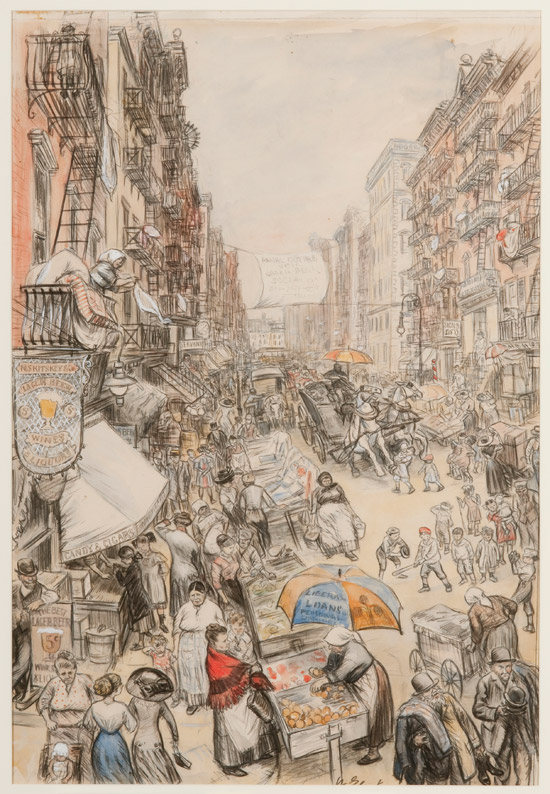
"Far From the Fresh Air Farm: the Crowded City Street, with Its Dangers and Temptations, Is a Pitiful Makeshift Playground for Children" by William J. Glackens, 1911. Charcoal on paper, 24 1/2 x 16 1/2 inches. Collection of Museum of Art Fort Lauderdale, Nova Southeastern University; Bequest of Ira Glackens, 91.40.106.
.
He moves uptown with Christmas Shoppers, Madison Square (1912), giving a more upscale take on a favorite theme, the rise of retail activity in rapidly expanding New York City, flush with countless tell-tale signs of the Gilded Age before World War I. Again finding drama in the foreground, he shows a man pick-pocketing a woman watching a bus loaded with shoppers. Both drawings reveal the artist’s affection for New York’s energy, even as he shrewdly portrays greedy and hardly kid-friendly consequences of those city crowds.
.
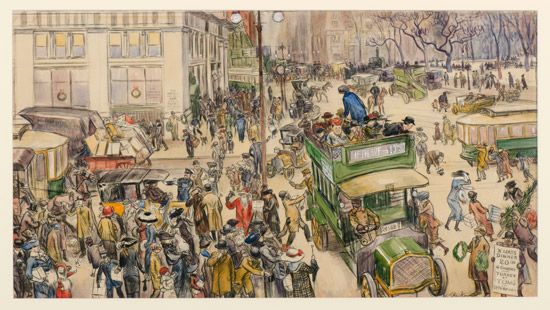
"Christmas Shoppers, Madison Square" by William J. Glackens, 1912. Crayon and watercolor on paper, 17 1/4 x 31 inches. Collection of Museum of Art Fort Lauderdale, Nova Southeastern University; Bequest of Ira Glacken, 91.40.106.
.
Modernist Painter Loved Color
Numerous paintings—with brilliant hues and exuberant, sensuous brushwork—are the prime attraction here, though some may appear overly indebted to classics by Renoir and other French masters. His 1918 portrait of his daughter wearing a Chinese costume, lovingly rendered in blues and reds, clearly recalls Renoir’s talent for endowing his subjects with gentle charm.
Girl with Apple (1909-10) is a somewhat stilted reference to Manet’s iconic nude, Olympia (1863-65). The overt sexuality of Manet’s painting caused a hostile stir at the time, but now many consider it the first example of modern painting. By comparison, the Glackens painting simply doesn’t convey Olympia’s dramatic power. Far more compelling is the artist’s Back of Nude (c. 1930s), with its feathery sweep of green, ivory, and pink brushstrokes rendering the back of a woman arranging her hair.
.
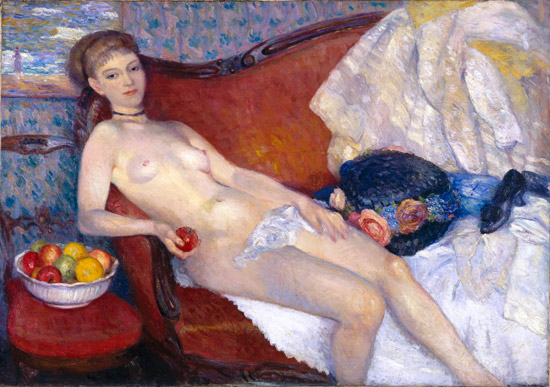
"Girl with Apple" by William J. Glackens, 1909-1910. Oil on canvas, 39 7/16 x 56 3/16 inches. Brooklyn Museum, Dick S. Ramsay Fund, 56.70.
.
Radiant with sumptuous color, Cape Cod Pier (1908) shows elegant women in white on a pier walking away from the water and toward land, dunes rendered in fiery orange shades as they rise to an intense contrast with soft blues, mauves, and pinks in an undulating ribbon of sky.
.

"Cape Cod Pier" by William J. Glackens, 1908. Oil on canvas, 26 x 32 inches. Collection of Museum of Art Fort Lauderdale, Nova Southeastern University; gift of an anonymous donor, 85.74.
.
Mahone Bay (1910), which Barnes purchased before sending Glackens to Paris to buy paintings, is another example of the artist’s modernist way with sun-splashed color. It captures seaside rhythms of a fashionable resort in Nova Scotia, with sailboats near shore and couples strolling dockside.
.
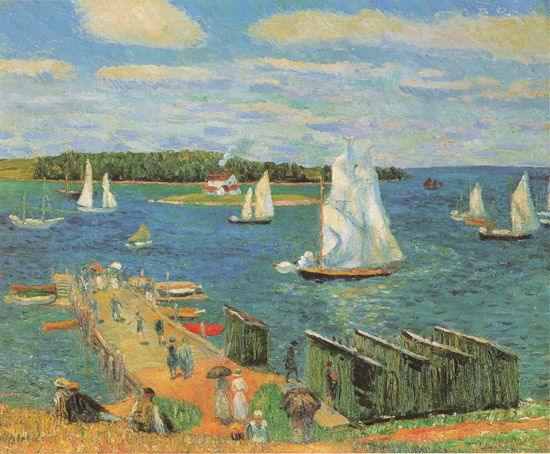
"Mahone Bay" by WIlliam J. Glackens, 1910. Oil on canvas, 26 1/8 x 31 7/8 inches. Sheldon Museum of Art, University of Nebraska-Lincoln, UNL - Anna R. and Frank M. Hall Trust, H-193.
.
Though Glackens is particularly remembered for his city scenes and beguiling landscapes often bustling with figures, he loved arranging compositions for still-lifes, painting more than 150 “floral portraits,” as they were called. In the 1920s, his still-lifes, such as Still Life with Three Glasses (mid-1920s), demonstrated affinities with how Matisse employed decorative patterns. The flattened space here contrasts with the strong sense of perspective in works such as Cape Cod Pier, and further emphasizes the almost abstract, decorative and floral forms enlivening this vibrant composition. With seasoned talent, once again Glackens draws us into a modernist vision of dazzling orange, gold and blue.
.
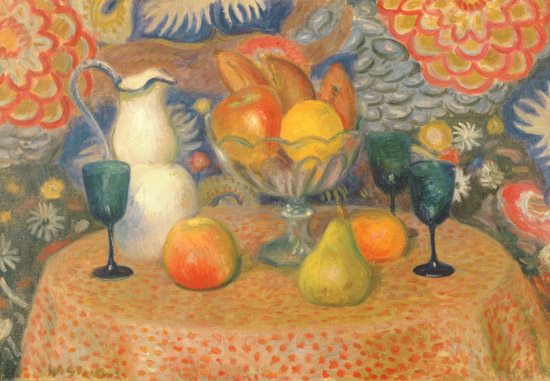
"Still Life with Three Glasses" by William J. Glackens, mid-1920's. Oil on canvas, 20 x 29 inches. Collection of the Butler Institute of American Art, Youngstown, OH, Museum Purchase 1957, 957-O-111.
.
Expect to see more impressive scholarship regarding Glackens from NSU Museum of Art (MOA|FL) which holds more than 500 Glackens works. Under development is its William Glackens Collection Initiative, including the William Glackens Research Collection and Study Center, supported by a grant from the Art Works program of the National Endowment for the Arts.
BASIC INFO: “William Glackens” is exhibited through June 1, 2014, at NSU Museum of Art Fort Lauderdale, One East Las Olas Boulevard, Fort Lauderdale, FL 33301. For details, visit www.moafl.org.
“William Glackens” next travels to the Parrish Art Museum in Water Mill, NY. It will be exhibited from July 27 to Oct. 13, 2014. Afterwards, it travels to the Barnes Foundation in Philadelphia from Nov. 8, 2014 to Feb. 2, 2015.
________________________
Copyright 2014 Hamptons Art Hub LLC. All rights reserved.

Dear Elisa,
It was a pleasure, as usual, to read your insightful review of our Glackens exhibition. I’m sure that Ms. Berman will enjoy reading it too. Take care and keep up the good work
Jorge